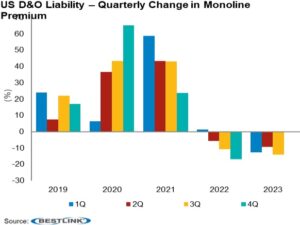Rating agency AM Best has assigned a negative outlook to the U.S. directors and officers liability insurance segment as more market entrants increase capacity and drive down pricing in the face of some troubling potential risk exposures.
“The current pricing environment may prove unsustainable based on developing losses and how those losses affect company underwriting results prospectively,” said Elizabeth Blamble, senior financial analyst in a statement.
 AM Best said underwriting “is becoming more lax” with some insurers offering broad coverage with low retentions as claims losses from prior years are still developing or currently being settled mainly due to remnants of shutdowns or slowdowns in the court system from the pandemic. Meanwhile, new entrants without legacy claims keep growing their books.
AM Best said underwriting “is becoming more lax” with some insurers offering broad coverage with low retentions as claims losses from prior years are still developing or currently being settled mainly due to remnants of shutdowns or slowdowns in the court system from the pandemic. Meanwhile, new entrants without legacy claims keep growing their books.
Currently, “supply outweighs demand, especially for risks with favorable loss history,” AM Best said in a separate market segment report.
Premium declines—down nearly 20 percent from a 2021 peak—follows a period of increases to catch up with underpricing and an increasingly litigious environment that led to unfavorable prior year reserve development. However, the courtroom slowdown and declines in demand for transactional risk and initial public offerings drove premiums down. D&O direct premiums written declined to an estimated $12 billion in 2023 from a peak of nearly $15 billion in 2021.
AM Best appears concerned that “pricing may have swung to quickly.” Moderate premium increases in 2022 didn’t keep up with economic inflation and, taking into account the added impact of social inflation and litigation funding, D&O insurers may see adverse reserve development on prior accident years.
Add to this the development of environment. social and governance (ESG) risk, leading to larger exposures. AM Best said ESG cases have more than doubled in the last decade and the trend is “not expected to decline.” Furthermore, the emergence of artificial intelligence-related adds risk exposure by way of regulatory frameworks and misuse.
“So far this year, a few prominent public companies have noted in their fourth-quarter earnings calls that they have experienced adverse development on certain casualty lines of business,” said Christopher Graham, senior industry analyst.





















 Dear Elon and Vivek: Insurance Commissioners Urge DOGE to Ditch FIO
Dear Elon and Vivek: Insurance Commissioners Urge DOGE to Ditch FIO  NWS Preliminary Estimate for 2024: More Than 5,300 Hail Events, 1,855 Tornadoes
NWS Preliminary Estimate for 2024: More Than 5,300 Hail Events, 1,855 Tornadoes  Slideshow: Carrier Management’s 2024 Top Editor’s Picks (Unlocked)
Slideshow: Carrier Management’s 2024 Top Editor’s Picks (Unlocked)  2025 Underwriting Profit and ‘Shop-a-Palooza’ Predicted for Auto Insurance
2025 Underwriting Profit and ‘Shop-a-Palooza’ Predicted for Auto Insurance 